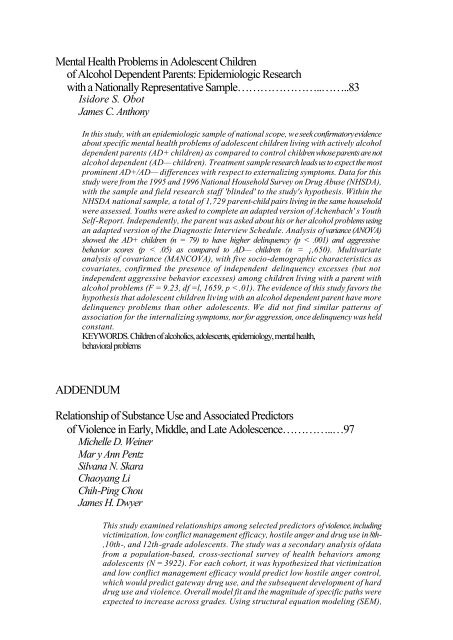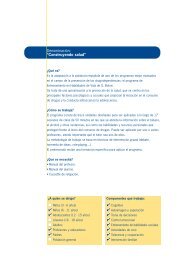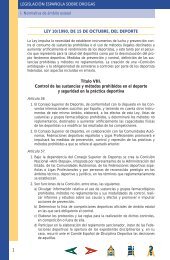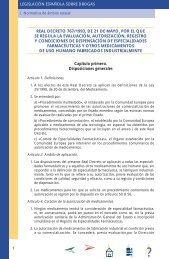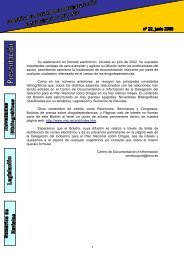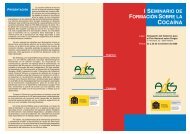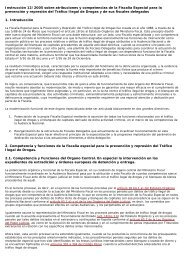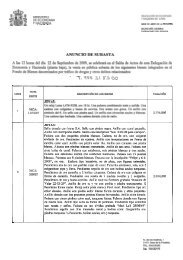1 Su elaboración en formato electrónico, iniciada en julio de 2002 ...
1 Su elaboración en formato electrónico, iniciada en julio de 2002 ...
1 Su elaboración en formato electrónico, iniciada en julio de 2002 ...
- No tags were found...
You also want an ePaper? Increase the reach of your titles
YUMPU automatically turns print PDFs into web optimized ePapers that Google loves.
M<strong>en</strong>tal Health Problems in Adolesc<strong>en</strong>t Childr<strong>en</strong>of Alcohol Dep<strong>en</strong>d<strong>en</strong>t Par<strong>en</strong>ts: Epi<strong>de</strong>miologic Researchwith a Nationally Repres<strong>en</strong>tative Sample…………………..……..83Isidore S. ObotJames C. AnthonyIn this study, with an epi<strong>de</strong>miologic sample of national scope, we seek confirmatory evid<strong>en</strong>ceabout specific m<strong>en</strong>tal health problems of adolesc<strong>en</strong>t childr<strong>en</strong> living with actively alcohol<strong>de</strong>p<strong>en</strong>d<strong>en</strong>t par<strong>en</strong>ts (AD+ childr<strong>en</strong>) as compared to control childr<strong>en</strong> whose par<strong>en</strong>ts are notalcohol <strong>de</strong>p<strong>en</strong>d<strong>en</strong>t (AD— childr<strong>en</strong>). Treatm<strong>en</strong>t sample research leads us to expect the mostpromin<strong>en</strong>t AD+/AD— differ<strong>en</strong>ces with respect to externalizing symptoms. Data for thisstudy were from the 1995 and 1996 National Household <strong>Su</strong>rvey on Drug Abuse (NHSDA),with the sample and field research staff 'blin<strong>de</strong>d' to the study's hypothesis. Within theNHSDA national sample, a total of 1,729 par<strong>en</strong>t-child pairs living in the same householdwere assessed. Youths were asked to complete an adapted version of Ach<strong>en</strong>bach' s YouthSelf-Report. In<strong>de</strong>p<strong>en</strong>d<strong>en</strong>tly, the par<strong>en</strong>t was asked about his or her alcohol problems usingan adapted version of the Diagnostic Interview Schedule. Analysis of variance (ANOVA)showed the AD+ childr<strong>en</strong> (n = 79) to have higher <strong>de</strong>linqu<strong>en</strong>cy (p < .001) and aggressivebehavior scores (p < .05) as compared to AD— childr<strong>en</strong> (n = ¡,650). Multivariateanalysis of covariance (MANCOVA), with five socio-<strong>de</strong>mographic characteristics ascovariates, confirmed the pres<strong>en</strong>ce of in<strong>de</strong>p<strong>en</strong>d<strong>en</strong>t <strong>de</strong>linqu<strong>en</strong>cy excesses (but notin<strong>de</strong>p<strong>en</strong>d<strong>en</strong>t aggressive behavior excesses) among childr<strong>en</strong> living with a par<strong>en</strong>t withalcohol problems (F = 9.23, df =l, 1659, p < .01). The evid<strong>en</strong>ce of this study favors thehypothesis that adolesc<strong>en</strong>t childr<strong>en</strong> living with an alcohol <strong>de</strong>p<strong>en</strong>d<strong>en</strong>t par<strong>en</strong>t have more<strong>de</strong>linqu<strong>en</strong>cy problems than other adolesc<strong>en</strong>ts. We did not find similar patterns ofassociation for the internalizing symptoms, nor for aggression, once <strong>de</strong>linqu<strong>en</strong>cy was heldconstant.KEYWORDS. Childr<strong>en</strong> of alcoholics, adolesc<strong>en</strong>ts, epi<strong>de</strong>miology, m<strong>en</strong>tal health,behavioral problemsADDENDUMRelationship of <strong>Su</strong>bstance Use and Associated Predictorsof Viol<strong>en</strong>ce in Early, Middle, and Late Adolesc<strong>en</strong>ce…………..…97Michelle D. WeinerMar y Ann P<strong>en</strong>tzSilvana N. SkaraChaoyang LiChih-Ping ChouJames H. DwyerThis study examined relationships among selected predictors of viol<strong>en</strong>ce, includingvictimization, low conflict managem<strong>en</strong>t efficacy, hostile anger and drug use in 8th-,10th-, and 12th-gra<strong>de</strong> adolesc<strong>en</strong>ts. The study was a secondary analysis of datafrom a population-based, cross-sectional survey of health behaviors amongadolesc<strong>en</strong>ts (N = 3922). For each cohort, it was hypothesized that victimizationand low conflict managem<strong>en</strong>t efficacy would predict low hostile anger control,which would predict gateway drug use, and the subsequ<strong>en</strong>t <strong>de</strong>velopm<strong>en</strong>t of harddrug use and viol<strong>en</strong>ce. Overall mo<strong>de</strong>l fit and the magnitu<strong>de</strong> of specific paths wereexpected to increase across gra<strong>de</strong>s. Using structural equation mo<strong>de</strong>ling (SEM),


